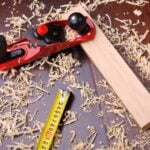Woodworking lathes have been steadily gaining popularity among DIY enthusiasts and woodworking hobbyists. With the ability to create beautifully turned wood pieces, these machines have become essential tools in the workshop. In this article, we will delve into the world of woodworking lathes, exploring what they are, how they work, and most importantly, how to make your very own from scratch.
As more individuals embrace the art of woodturning, the demand for quality woodworking lathes has grown exponentially. These machines allow craftsmen to shape and carve wood with precision, creativity, and speed. Whether you want to create decorative bowls, intricate pens, or unique jewelry pieces, a woodworking lathe is an indispensable tool that can bring your visions to life.
Before diving into the process of making a woodworking lathe, it’s important to understand what exactly it is and how it functions. A lathe is a machine used for rotating a workpiece on its axis while various cutting or shaping tools are applied to it.
The rotation allows for even and controlled cuts on the wood piece, making it easier to achieve desired shapes and designs. By building your own woodworking lathe, you not only have control over its design and features but you also save money compared to purchasing a pre-made one.
In the following sections of this article:
- Section 2 will provide an in-depth understanding of what a woodworking lathe is and how it works.
- Section 3 will guide you through gathering all the essential tools and materials needed for building your own woodworking lathe.
- Section 4 will serve as a step-by-step guide on constructing your custom-built lathe from start to finish.
Whether you’re a beginner or an experienced woodworker looking for new ways to expand your craft, building your own woodworking lathe opens up endless possibilities for creativity. So let’s roll up our sleeves and get ready to embark on this exciting journey of creating our very own woodworking lathe.
Understanding the Basics
A woodworking lathe is a machine used for shaping wood by rotating it rapidly along its axis while various cutting tools are applied to shape and carve the material. The lathe consists of several key components, including the headstock, tailstock, tool rest, and motor. Understanding the basics of how a woodworking lathe works is essential for anyone interested in building their own lathe or embarking on woodworking projects.
The main function of a woodworking lathe is to rotate a workpiece around its axis while allowing the woodworker to remove material using sharp cutting tools. The rotation can be adjusted to different speeds depending on the desired outcome and type of project. The headstock houses a mechanism that enables the workpiece to rotate, while the tailstock provides support for longer pieces of wood.
To shape and carve the wood, a tool rest is positioned near the workpiece, providing stability and control during operation. Different cutting tools, such as gouges and chisels, are used to manipulate the wood according to the woodworker’s design. By carefully guiding these tools along the spinning workpiece, intricate shapes and decorative details can be achieved.
Understanding how a woodworking lathe works is crucial before attempting to build one from scratch. It allows aspiring woodworkers to grasp the functionality of each component and consider design considerations when constructing their own lathe. By learning about the basic principles of operation, enthusiasts can confidently move forward in their journey towards fulfilling their woodworking dreams with a custom-built lathe.
| Component | Description |
|---|---|
| Headstock | Houses mechanism for rotating workpiece |
| Tailstock | Provides support for longer pieces of wood |
| Tool Rest | Platform for stability and control during operation |
| Cutting Tools | Gouges and chisels used to shape and carve wood |
| Motor | Drives the rotation of the workpiece |
Essential Tools and Materials
Building a woodworking lathe from scratch requires a variety of essential tools and materials. To ensure a successful build, it is important to gather everything you need before beginning the construction process.
One of the most crucial tools you will need is a set of basic hand and power tools. These may include a saw, chisels, screwdrivers, drills, clamps, measuring tools (such as rulers and calipers), and sanding equipment. Additionally, having access to specialized woodworking tools such as a lathe chuck key, live center, spindle gauge, and parting tools will make the construction process smoother.
In terms of materials, the body of the lathe is typically made from wood. It is important to select a strong and durable timber that will provide stability for your lathe. Popular choices include maple, ash, oak, or birch. You will also need various components made from metal or other durable materials including the headstock and tailstock assembly, tool rest holder, motor mount bracket, and controls.
Lastly, don’t forget about safety equipment. Building a woodworking lathe can involve sharp objects and potentially dangerous power tools. Therefore, it is crucial to have safety goggles or glasses to protect your eyes from flying debris. A dust mask should also be worn when sanding or cutting wood to prevent inhaling harmful particles.
By gathering all the necessary tools and materials beforehand, you can ensure that you have everything on hand when it comes time to construct your woodworking lathe. This will help streamline the process and make it easier for you to focus on building your custom machine without unnecessary interruptions or delays.
Step-by-Step Guide
Building your own woodworking lathe from scratch can be a rewarding and fulfilling project for any woodworking enthusiast. By constructing your own lathe, you have the opportunity to customize it to meet your specific needs and preferences. In this step-by-step guide, we will walk you through the process of building your own woodworking lathe.
To begin, it is essential to consider the design of your lathe. Think about the type and size of lathe that will best suit your woodworking projects. There are various types available, including bowl lathes, spindle lathes, and duplicating lathes. Consider the size of the lathe as well, as this will determine the maximum length and diameter of the wood pieces you can work with.
Next, select a suitable type of wood for constructing your lathe’s body and components. You will need sturdy, durable wood that can withstand regular usage and vibrations. Species such as maple or oak are often recommended for their strength and stability.
Once you have gathered all necessary tools and materials, it is time to start building. Begin by constructing the base of your lathe, ensuring it is stable and sturdy enough to support the weight of the machine during operation. This will provide a secure foundation for all other components.
After building the base, proceed to assemble the headstock and tailstock. The headstock houses the motor or drive system which powers the rotation of the workpiece while the tailstock provides support on the opposite end. Refer to detailed plans or instructions for proper alignment and attachment.
Next, build a tool rest – a platform that holds your cutting tools in place while shaping wood. This is an important component for controlling cuts and creating precise designs. Ensure that it is securely attached to provide stability during use.
Once the tool rest is in place, it is time to install the spindle – a rotating component that holds and spins your workpiece – along with a live center for support. This allows for rotation and stability while you shape your wood.
To bring your lathe to life, add a motor and controls. This will allow you to control the speed and power of your lathe. Follow manufacturer instructions for wiring and installation, ensuring all connections are secure before testing.
Finally, take the time to fine-tune your lathe and implement important safety measures. Check for any potential issues such as misalignments or loose components. Additionally, make sure you have protective gear such as goggles and earplugs, and familiarize yourself with safe operating procedures.
Building your own woodworking lathe from scratch can be a rewarding endeavor that allows you to unleash your creativity in woodworking projects. By following these step-by-step instructions, you will have a custom-built lathe that is tailored to your needs and preferences. Now that your lathe is complete, it’s time to start creating stunning woodturning projects.
Tips and Tricks
Woodworking lathes are versatile tools that can be further enhanced to improve their performance and expand their capabilities. By incorporating certain upgrades and accessories, you can tailor your woodworking lathe to better suit your specific projects and achieve optimal results. Here are some tips and tricks to enhance your woodworking lathe:
- Upgrading the Drive System: One way to enhance your lathe’s performance is by exploring different powered options for the drive system. While traditional lathes are often operated manually using hand tools, adding a motorized drive system can greatly increase efficiency and ease of use. There are various options available, such as belt-driven systems or electronic variable speed motors, which provide smoother rotation and greater control over turning speeds.
- Adding Variable Speed Control: Tailoring the rotation speed to your projects is crucial for achieving optimal results. Incorporating a variable speed control feature allows you to adjust the speed based on the type of wood you’re working with and the desired outcome. This is particularly useful when working with delicate or intricate designs that require precision and finer control.
- Incorporating a Bed Extension: Enlarging the capacity of your lathe can be achieved by adding a bed extension. This extension provides extra length, allowing you to work on larger pieces of wood or undertake projects that require more space. With a bed extension, you can take on challenging projects like turning table legs or even larger bowls without limitations, giving you greater versatility in your woodworking endeavors.
- Installing Additional Accessories: To further expand the capabilities of your woodworking lathe, consider installing additional accessories such as chucks and faceplates. Chucks securely hold the workpiece in place while faceplates allow for easy attachment of irregularly shaped or oversized pieces of wood. These accessories open up possibilities for more complex turning techniques and enable you to tackle a wider range of projects.
By implementing these tips and tricks, you can enhance the performance of your woodworking lathe and elevate your woodworking skills. Experimenting with different upgrades and accessories will enable you to explore new techniques, take on more challenging projects, and achieve the best possible results in your woodworking endeavors. Remember to always follow safety guidelines and refer to the lathe’s manual when making any modifications or enhancements.
Safety First
Woodworking lathes can be powerful and versatile tools, but they also pose certain risks if not used properly. Prioritizing safety is essential when operating a woodworking lathe. Here are some important precautions and best practices to follow:
Wear Appropriate Safety Gear
When using a woodworking lathe, it is crucial to protect yourself with the right safety gear. Wear safety glasses or a face shield to shield your eyes from wood chips or debris that may fly off during operation. Additionally, consider wearing hearing protection as lathes can produce loud noises. Lastly, make sure to wear snug-fitting clothing and avoid loose sleeves or jewelry that may get tangled in the lathe.
Secure Your Workpiece
Before starting the lathe, ensure that your workpiece is properly secured and balanced on the spindle or chuck. Use appropriate holding mechanisms like center points, faceplates, or chucks to prevent the workpiece from shifting or becoming loose during rotation. Improperly secured workpieces can cause dangerous vibrations and accidents.
Follow Correct Cutting Techniques
Learning and practicing proper cutting techniques is crucial for safe lathe usage. Always position your cutting tools correctly, making sure they are sharp and in good condition. Remember to start with light cuts and gradually increase the depth as you become more comfortable with the lathe. Avoid using excessive force or pushing too hard against the rotating wood as it can lead to kickback or tool breakage.
Maintain a Clear Workspace
Keep your workspace clean and organized while operating a woodworking lathe. Clear away any clutter or debris that could potentially interfere with your movement around the machine. Make sure there is ample space around you while working so you can maneuver safely without obstacles hindering your movements.
Practice Proper Tool Rest Positioning
Positioning the tool rest correctly is crucial for safe woodworking lathe operation. The tool rest should be set as close to the workpiece as possible, without interfering with its rotation. Align the tool rest parallel to the axis of rotation and adjust it to the appropriate height relative to your cutting tool. Regularly check that the tool rest remains securely in place throughout your turning process.
Do Not Leave the Lathe Unattended
Never leave a woodworking lathe running unattended, even if it’s just for a short period. Accidents can happen within seconds, and it is essential to maintain constant control over the machine. Always turn off the lathe and wait for it to come to a complete stop before leaving it unattended.
By following these important safety precautions and best practices, you can ensure a safer working environment while using a woodworking lathe. Remember, prioritizing safety allows you to fully enjoy your woodworking projects without unnecessary risks or accidents.
Inspiring Projects
In the world of woodworking, a homemade lathe opens up endless possibilities for creative projects. With your own woodworking lathe, you can easily turn ordinary pieces of wood into stunning works of art. In this section, we will explore some inspiring projects that showcase the incredible things you can create with your custom-built lathe.
Turning Bowls and Vases: Mastering the Art of Hollow Forms
One of the most popular projects for woodworking lathes is turning bowls and vases. With a few basic techniques and some practice, you can transform a simple block of wood into a beautiful hollow form. The process involves mounting the wood securely on the lathe’s spindle and using turning tools to shape it into the desired bowl or vase shape. This allows you to create unique pieces that are not only functional but also aesthetically pleasing.
Designing and Crafting Wood Pens: Small But Intricate Creations
Wooden pens have become increasingly popular among enthusiasts and collectors alike. Crafting your own wooden pens with a homemade lathe allows you to personalize them according to your preferences and make unique gifts for friends and family.
To craft a wooden pen, you will need to turn small sections of wood into the pen body using precision techniques. With various types of wood available, you can experiment with different colors, patterns, and finishes to create truly one-of-a-kind writing instruments.
Creating Unique Wood Jewelry: Incorporating Lathe Work in Adornments
Wood jewelry has gained attention in recent years as an alternative to traditional metal pieces. By incorporating lathe work in creating wood jewelry, you can produce stunning pendants, earrings, bracelets, and even rings. Using small sections of highly figured or exotic woods such as ebony or maple burl, you can turn them into intricate beads or pendants that showcase natural beauty. Additionally, combining wood elements with other materials like metal or gemstones can add a unique touch to your designs.
By exploring these inspiring projects, you can see the diverse range of items that can be created using a homemade lathe. Whether it’s turning bowls and vases, crafting wooden pens, or creating wood jewelry, your custom-built lathe opens up a world of creative possibilities.
The satisfaction of working with your own hands and the joy of seeing the finished product is what makes woodworking with a lathe such a rewarding hobby. So let your imagination run wild and start creating incredible pieces with your homemade lathe today.
Maintenance and Troubleshooting
Maintaining a woodworking lathe and troubleshooting any issues that arise is essential for keeping it in optimal condition. Regular maintenance will ensure that your lathe continues to function smoothly and efficiently, while troubleshooting helps identify and solve any problems that may hinder its performance. In this section, we will discuss some important maintenance practices and troubleshooting tips to help you keep your woodworking lathe in prime condition.
Regular Maintenance
To maintain the longevity of your woodworking lathe, it is crucial to perform regular maintenance tasks. Here are some key maintenance practices to keep in mind:
- Cleaning: Regularly clean your lathe after every use to remove wood particles, dust, and debris. Vacuum or use compressed air to clean hard-to-reach areas.
- Lubrication: Apply lubricant on moving parts such as the headstock spindle bearings, tailstock quill, and tool rest banjo regularly. This will minimize friction and prevent premature wear.
- Belt Tension: Check the tension of the drive belt regularly. A loose belt can cause slippage and affect the lathe’s performance.
- Checking for Wear: Inspect all components of the lathe for signs of wear or damage such as loose fittings or cracks in the bed or tool rest. Replace any worn-out parts promptly.
Troubleshooting Tips
Despite proper maintenance, issues may occasionally arise with your woodworking lathe. Here are some common problems you may encounter and their potential solutions:
- Vibration: Excessive vibration can occur due to an unbalanced workpiece, a loose chuck or faceplate, or an incorrectly aligned tool rest. Ensure that your workpiece is properly balanced and secured, tighten all attachments securely, and adjust the tool rest alignment if necessary.
- Motor Issues: If your motor is not starting or running smoothly, check for loose connections in the wiring or faulty switches. Ensure that the motor is well-lubricated and clean the brushes regularly.
- Uneven Cutting: If your lathe is producing uneven cuts, it may be due to dull tools or incorrect tool rest positioning. Sharpen your cutting tools regularly and ensure that the tool rest is aligned parallel to the workpiece.
- Excessive Noise: Unusual noise may indicate loose fittings, worn bearings, or improperly tensioned belts. Inspect all components and tighten any loose parts, replace worn-out bearings, and adjust belt tension as needed.
Regular maintenance and prompt troubleshooting will help keep your woodworking lathe in prime condition for years to come. By following these maintenance practices and solutions for common problems, you can ensure smooth operation and enjoy the full potential of your custom-built lathe.
Final Thoughts
Building your own woodworking lathe from scratch can be a rewarding and fulfilling experience. Not only will you have a custom-built tool that suits your specific needs, but you will also gain valuable knowledge and skills along the way. By following the step-by-step guide outlined in this article, you can create a sturdy and functional lathe that is capable of producing remarkable woodturning projects.
As you progress through the building process, it’s important to remember safety precautions and best practices for woodworking lathe usage. Always wear appropriate safety gear such as goggles and gloves, and make sure to secure your workpiece properly before turning it on. Additionally, regular maintenance and troubleshooting are vital to keep your lathe in prime condition. Regularly clean and lubricate all moving parts, check for any loose screws or bolts, and make any necessary repairs or adjustments as needed.
Once your lathe is built and ready to go, the possibilities for what you can create are endless. Whether you’re interested in turning bowls and vases with intricate hollow forms, designing and crafting wooden pens with delicate details, or creating unique wood jewelry pieces that incorporate lathe work, your homemade lathe will be there to bring your visions to life.
In conclusion, don’t hesitate to embark on the journey of building your own woodworking lathe. With the right tools, materials, guidance, and a little bit of patience, you can fulfill your woodworking dreams while gaining valuable skills along the way. So go ahead, start building your custom-built lathe today and let your creativity shine through every project you undertake. Happy woodworking.
Frequently Asked Questions
Can you build your own lathe?
Building your own lathe is definitely possible, but it requires a certain level of knowledge and skill in woodworking and metalworking. You would need to have a good understanding of how a lathe functions, as well as access to the necessary tools and materials.
There are various resources available, such as books or online tutorials, that can guide you through the process of constructing your own lathe. It’s important to note that building a lathe from scratch can be a challenging and time-consuming project, so it’s essential to carefully consider your abilities and resources before embarking on such an endeavor.
Can you build a wood lathe?
Yes, it is possible to build a wood lathe. In fact, many woodworking enthusiasts choose to construct their own wood lathes because it allows for customization based on their specific needs and preferences. DIY plans for building wood lathes are available online and in woodworking books.
The process typically involves gathering materials like wooden boards or plywood for the bed, headstock, tailstock, and tool rest. You would also need various hardware components such as bearings or bushings, along with basic tools like saws, drills, and sandpaper. Following detailed instructions and diagrams, you can assemble the components into a functional turning machine capable of shaping wood.
What can I use instead of a lathe?
If you don’t have access to a lathe or prefer not to build one yourself, there are alternative methods you can use for certain tasks traditionally done on a lathe. For example, if you need to shape small wooden objects like dowels or spindles, you could use a hand-held rotary tool equipped with appropriate attachments such as sanding drums or carving burrs. This allows you to manually turn the wood while using the rotary tool to remove material or create desired shapes.
Another option is using a simple technique called “bow turning” where you secure one end of the workpiece between centers while holding the other end with a flexible bow-shaped apparatus. This allows you to spin the workpiece by moving the bow back and forth, providing a rudimentary rotating motion for shaping or carving. However, it’s important to note that these alternative methods have limitations and may not offer the same precision and versatility as a dedicated lathe.

Hi everyone! I’m a woodworker and blogger, and this is my woodworking blog. In my blog, I share tips and tricks for woodworkers of all skill levels, as well as project ideas that you can try yourself.





